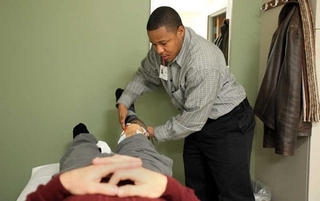Blame it on babies, the ski season or long work hours and repetitive motion.
Jenny Baldwin, a veterinary assistant in Farmington Hills, traces the shooting pain in her wrist to fat and panicked cats.
"Some of them can be really strong. You'd be surprised what a Persian ... can do when it's being restrained," she says.
After 10 years of wrestling wriggling patients at the Carousel Cat Clinic, Baldwin, 39, will undergo surgery in January for something that's surprisingly common: de Quervain's tendonitis.
It's an inflammation of the tendons that run along the base of the thumb and along the wrist. It's especially a problem for mothers with new babies, and can make the easiest tasks nearly impossible.
"Picking up a cup of coffee -- it really hurt," says Brianne Colling, a 28-year-old Canton mother of 21-month-old William.
Avoid the L
Dr. Rachel Rohde, an orthopedic surgeon at Beaumont Hospital, Royal Oak, says she sees three or four cases each week.
"I often ask patients, 'Is there a new baby around?' " says Rohde, a spokeswoman for the American Academy of Orthopedic Surgeons.
That's because moms especially are lifting babies and toddlers by forming an 'L' with their thumb and forefinger and hooking the babies under their armpits. They use that same 'L' while they're cradling a newborn to breastfeed.
It's also believed that the swelling pregnancy brings about also might predispose women to the tendonitis, says Rohde, who treats both Baldwin and Colling.
Colling laughs when people ask her about the splint she sometimes wears -- "Avoid the L," she tells them .
Her pain began when William -- born at what she called a "chunky" 8 pounds, 11 ounces -- was about 6 months old.
"At first, I noticed when I woke up from a random nap, it was locked into place and it popped. I was like 'Wow, that hurt, what was that?' I blew it off (thinking) I must have slept wrong."
But as William grew, so did the pain in Colling's wrist. Eventually, daily activities like washing her hair or throwing her purse over her shoulder became painful.
Simple measures -- ice, anti-inflammatory medication -- might help some cases; the worst cases might need surgery.
Men hurt, too
Estimates vary, but this much is clear: De Quervain's is reported much more often in women than men, possibly because of the new-baby factor that increases the odds for moms and grandmas -- the more traditional caregivers for babies, says Dr. Fraser Leversedge, an assistant professor in the Department of Orthopaedic Surgery at Duke University.
But men are hardly immune, he says.
In fact, anyone whose job involves repetitive pinching and twisting at the same time, like electricians and plumbers who are torquing wrenches, are susceptible. So are skiers, especially those who cross-country ski, because of the pressure and rotation of the wrist as they plant their poles again and again.
Even if it's not repetitive, one straining event can irritate the tendon. So can a direct blow to the wrist, Leversedge says.
Dallas Mitchell's job as a physical therapist technician at Beaumont Medical Center, West Bloomfield means repetitive, circular motion as he works the ultrasound machinery in as many as a dozen procedures, each lasting several minutes, each day.
The pain and numbness started on the job, but eventually, even holding his breakfast bowl shot pains up his arm.
"That's a lot of interruption there for a bowl of cereal," says the 29-year-old Oak Park resident.
He tried ice and wore a brace -- measures that often provide relief for others. But Mitchell's pain persisted.
Ultimately, like Baldwin and Colling, he sought treatment from Rohde and the doctor suggested a cortisone shot.
"She did it right then and there, and in 10 minutes it was gone. I haven't had pain since" he says
A splint and two rounds of cortisone shots also have helped Colling, but she's expecting again in July and worries the pain will return with a new baby.
In the meantime, she's careful to "scoop" up William, who now tops 30 pounds, with her thumb flush to her hand.
If the pain returns, Rohde has suggested surgery.
Colling says that's OK: "You know, I'd be totally happy with surgery as long as I don't have those symptoms again."
ON THE COVER: Brianne Colling, with baby William, of Canton.










3
Comments >>
Read and share your thoughts on this story.